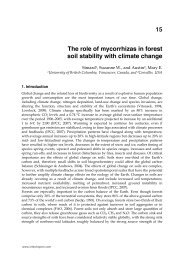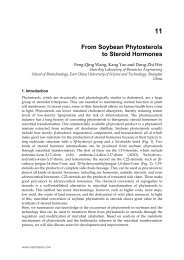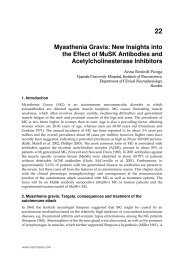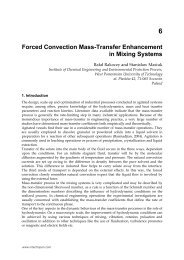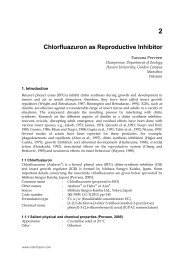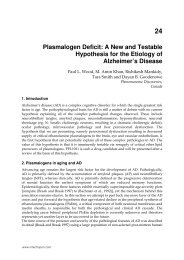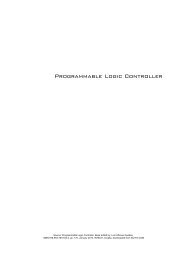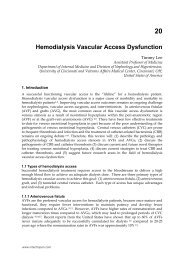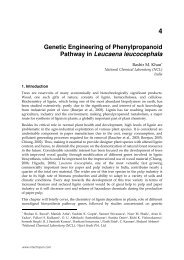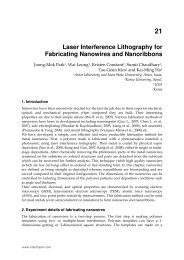Quality Control of Cordyceps sinensis Teleomorph ... - InTech
Quality Control of Cordyceps sinensis Teleomorph ... - InTech
Quality Control of Cordyceps sinensis Teleomorph ... - InTech
You also want an ePaper? Increase the reach of your titles
YUMPU automatically turns print PDFs into web optimized ePapers that Google loves.
<strong>Quality</strong> <strong>Control</strong> <strong>of</strong> <strong>Cordyceps</strong> <strong>sinensis</strong> <strong>Teleomorph</strong>, Anamorph, and Its Products<br />
Obviously, C. <strong>sinensis</strong> had 2 restriction sites—CfoI and RsaI (the signature sequence)—that<br />
could be used to differentiate C. <strong>sinensis</strong> from other <strong>Cordyceps</strong> spp. (Fig. 5). To ensure<br />
specificity <strong>of</strong> the signature sequence, the GenBank database was searched using the search<br />
phrase ’<strong>Cordyceps</strong> 18S rRNA gene’. Simultaneously, the NS5/NS6 region sequence was<br />
uploaded to GenBank and the database was searched for the sequences that were mostly<br />
closely related using the Basic Local Alignment Search Tool (BLAST) program (Altschul et<br />
al., 1990). None <strong>of</strong> the sequences contained both restriction sites (data not shown); thus, C.<br />
<strong>sinensis</strong> could be definitively identified based on the 2 restriction sites.<br />
The PCR-RFLP method based on the signature sequence was developed and used to<br />
characterize C. <strong>sinensis</strong> fermented products in Taiwan (Table 3).<br />
Marketing Sample a Sample Origin b Collection Date<br />
C. <strong>sinensis</strong> mycelium A June 2004<br />
C. <strong>sinensis</strong> mycelium AV June 2004<br />
C. <strong>sinensis</strong> mycelium B June 2004<br />
C. <strong>sinensis</strong> mycelium C June 2004<br />
C. <strong>sinensis</strong> and Ganoderma lucidum mycelia DP June 2004<br />
C. <strong>sinensis</strong> mycelium G1 June 2004<br />
C. <strong>sinensis</strong> mycelium Gen June 2004<br />
C. <strong>sinensis</strong> mycelium L June 2004<br />
C. <strong>sinensis</strong> mycelium NT June 2004<br />
C. <strong>sinensis</strong> mycelium P June 2004<br />
C. <strong>sinensis</strong> mycelium PH June 2004<br />
C. <strong>sinensis</strong> mycelium 4B June 2004<br />
aThe marketing sample content descriptions were provided by the respective suppliers.<br />
bFull company names related to the marketing samples are not shown here.<br />
Table 3. <strong>Cordyceps</strong> <strong>sinensis</strong> mycelium fermented products collected in the present study<br />
Among the 12 fermented products, only AV and L matched the signature sequence and<br />
were, therefore, considered genuine C. <strong>sinensis</strong> mycelium products (Fig. 6).<br />
Another 8 products—A, B, C, G1, Gen, NT, PH, and 4B, none <strong>of</strong> which were digested by CfoI<br />
and RsaI—were considered fake products. The product DP, whose content was labeled C.<br />
<strong>sinensis</strong> and Ganoderma lucidum mycelia, had 2 corresponding polymorphism patterns;<br />
however, the product P, whose content was labeled only as C. <strong>sinensis</strong> mycelium, must not<br />
exclusively comprise pure C. <strong>sinensis</strong> mycelium.<br />
4. Discussion<br />
ITS-region nrDNA, which consists <strong>of</strong> the 2 variable non-coding regions ITS 1 and ITS 2, was<br />
more broadly used in phylogenetic analysis than 18S nrDNA. However, the 2 C. <strong>sinensis</strong>-<br />
www.intechopen.com<br />
233




